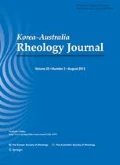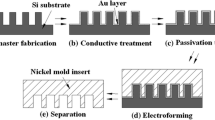Abstract
Because of increasing interest in the functional surfaces including micro- or nano-patterns, the mass production of such surfaces has been actively researched. Both conventional injection molding (CIM) and injection/compression molding (ICM) of micro-patterns were investigated in the present study. The molding subject is a multi-scale structure that consists of a macro-scale thin plate and micro-scale patterns formed regularly on its surface. The transcription ratios of micro pattern made by CIM and ICM for different flow length were experimentally measured, and the origin of the obtained results was identified through numerical analysis. It was found that the cavity pressure and polymer temperature are the most important factors for micro-pattern filling; in particular, the polymer temperature is the key factor determining the transcription ratio. It was also found that the difference in CIM and ICM micro-pattern transcription ratios originates from the differences in the cavity pressure history if other molding conditions are the same.
Similar content being viewed by others
References
Cahn, J.W. and J.E. Hilliard, 1958, Free energy of a nonuniform system. I. Interfacial free energy, J. Chem. Phys. 28, 258–267.
Chen, S.C., Y.C. Chenand, and H.S. Peng, 2000, Simulation of injection-compression-molding process. II. Influence of process characteristics on part shrinkage, J. Appl. Polym. Sci. 75, 1640–1654.
Heckele, M. and W.K. Schomburg, 2003, Review on micro molding of thermoplastic polymers. J. Micromech. Microeng. 14, R1–R14.
Hong, S., I. Min, K. Yoon, and J. Kang, 2014, Effects of adding injection-compression to rapid heat cycle molding on the structure of a light guide plate, J. Micromech. Microeng. 24, 015009.
Hong, S., J. Kang, and K. Yoon, 2015, Correlation between thermal contact resistance and filling behavior of a polymer melt into multiscale cavities in injection molding, Int. J. Heat Mass Transf. 87, 222–236.
Huang, H.-X., K. Li, and S. Li, 2008, Injection-compression molded part shrinkage uniformity comparison between semicrystalline and amorphous plastics, Polym. Plast. Technol. Eng. 48, 64–68.
Isayev, A.I., 2000, Molding processes, In: L.S. Richard and L.H. Ernest, eds., Handbook of Industrial Automation, CRC Press, Boca Raton, 573–606.
Ito, H. and H. Suzuki, 2009, Micro-features formation in injection compression molding, J. Solid Mech. Mater. Eng. 3, 320–327.
Kim, S. and L. Turng, 2006, Three-dimensional numerical simulation of injection molding filling of optical lens and multiscale geometry using finite element method, Polym. Eng. Sci. 46, 1263–1274.
Klepek, G., 1987, Herstellung optischer Linsen im Spritzprägeverfahren, Kunststoffe 77, 1147–1151.
Kuhn, S., A. Burr, M. Kubler, M. Deckertand, and C. Bleesen, 2010, Study on the replication quality of micro-structures in the injection molding process with dynamical tool tempering systems, Microsyst. Technol. 16, 1787–1801.
Lin, H.-Y. and W.-B. Young, 2009, Analysis of the filling capability to the microstructures in micro-injection molding, Appl. Math. Model. 33, 3746–3755.
Liu, K. and L. Jiang, 2011, Bio-inspired design of multiscale structures for function integration, Nano Today 6, 155–175.
Matsuda, S., A. Itoh, and T. Tamura, 1985, (No Title), Natl. Tech. Rep., 14, 641.
Min, I.K. and K. Yoon, 2011, An experimental study on the effects of injection-molding types for the birefringence distribution in polycarbonate discs, Korea-Aust. Rheol. J. 23, 155–162.
Osswald, T.A., L.S. Turng, and P.J. Gramann, 2008, Injection Molding Handbook, Hanser Verlag, Munich.
Shen, Y.K., 2007, Comparison of height replication properties of micro-injection moulding and micro-injection-compression moulding for production of microstructures on lightguiding plates, Plast. Rubber Compos. 36, 77–84.
Shen, Y.K., C.Y. Chang, Y.S. Shen, S.C. Hsuand, and M.W. Wu, 2008, Analysis for microstructure of microlens arrays on micro-injection molding by numerical simulation, Int. Commun. Heat Mass Transf. 35, 723–727.
Su, Y.-C., J. Shah, and L. Lin, 2004, Implementation and analysis of polymeric microstructure replication by micro injection molding, J. Micromech. Microeng. 14, 415.
Tofteberg, T., H. Amédro, and E. Andreassen, 2008, Injection molding of a diffractive optical element, Polym. Eng. Sci. 48, 2134–2142.
Yang, C., X.-H. Yin, and G.-M. Cheng, 2013, Microinjection molding of microsystem components: new aspects in improving performance, J. Micromech. Microeng. 23, 093001.
Yang, S.Y. and Y.C. Chen, 1998, Experimental study of injectioncharged compression molding of thermoplastics, Adv. Polym. Technol. 17, 353–360.
Yang, S.Y. and M.Z. Ke, 1995, Experimental study on the effects of adding compression to injection molding process, Adv. Polym. Technol. 14, 15–24.
Young, W.B., 2005, Simulation of the filling process in molding components with micro channels, Microsyst. Technol. 11, 410–415.
Yu, L., C.G. Koh, L.J. Lee, K.W. Koelling, and M.J. Madou, 2002, Experimental investigation and numerical simulation of injection molding with micro-features, Polym. Eng. Sci. 42, 871–888.
Yue, P., J.J. Feng, C. Liu and J. Shen, 2004, A diffuse-interface method for simulating two-phase flows of complex fluids, J. Fluid Mech. 515, 293–317.
Author information
Authors and Affiliations
Corresponding authors
Rights and permissions
About this article
Cite this article
Hong, S., Hwang, J., Kang, J. et al. Comparison of injection molding and injection/compression molding for the replication of microstructure. Korea-Aust. Rheol. J. 27, 309–317 (2015). https://doi.org/10.1007/s13367-015-0030-z
Received:
Revised:
Accepted:
Published:
Issue Date:
DOI: https://doi.org/10.1007/s13367-015-0030-z




